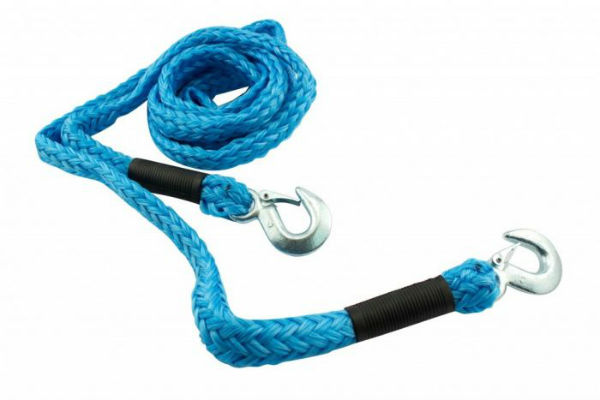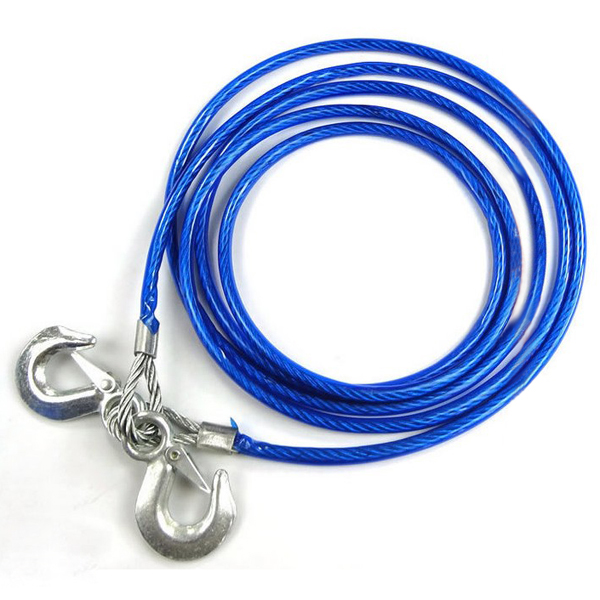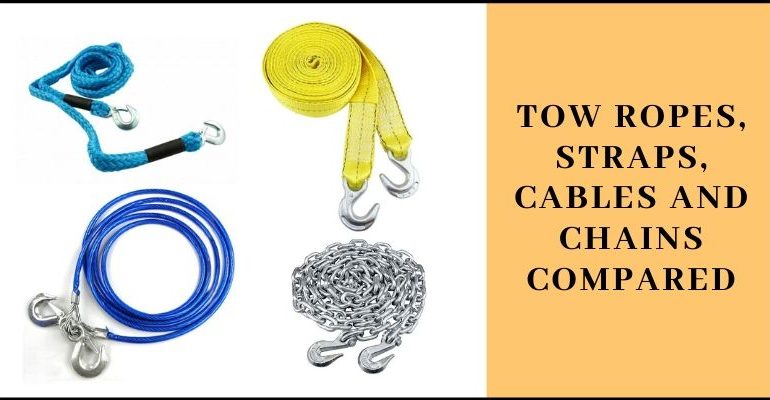Last updated on November 3rd, 2019 at 03:05 am
Most drivers who have been driving long enough have been in one undesirable situation one time or another. Perhaps your engine has died on you, and jump starting the battery simply couldn’t get the job done.
Maybe your car has broken down and it just happens that your breakdown cover has just run out, and calling for roadside assistance is no longer an option. Or perhaps you’re just trying to help a fellow driver out with a tow. Fortunately, you have a wide range of options when it comes to towing, and you won’t need a complete set of hitch equipment to do it.
It always pays to be prepared on the road, and the same goes for towing. The need for towing is simply something that you will not encounter very often, but when you do, you will be thankful that you have a set of tow straps in your trunk for such emergencies.
Maybe a set of tow ropes might serve you better, depending on the situation, or you have the right equipment and experience to make effective use of a tow cable. If you’re working around a farm, maybe a tow chain is a better fit for your towing needs.
Tow straps, tow ropes, tow cables and tow chains – each of these options have their advantages and disadvantages. It’s always a great idea to have a bit of familiarity with every one of them, just in case your options are limited at the time. In this guide, we look over at the essential tips when it comes to towing with these towing options.
Tow Straps: What Are They?

Tow straps are portable towing equipment designed for towing a freewheeling vehicle. They are usually made from Polyester, Polypropylene or Dacron, which give them impressive strength while remaining lightweight. Since tow straps are made to stretch only very slightly, these materials are ideal for making strong, stiff straps that have a high towing capacity and moderate abrasion resistance.
A tow strap may or may not have hooks at the ends. A tow strap with hooks is significantly more dangerous than a strap without hooks, as they can turn into deadly projectiles should the strap or mounting point fail and let go of the strap while it is under full tension. Tow straps with loops at the end are much safer than the ones with hooks, even those that come with safety latches.
Tow Straps: How Strong Are They?
Tow straps can come in widths from as narrow as 2 inches to as wide as 12 inches. The wider the tow strap, the higher is its rated break strength. Depending on the width and the number of plies, you can get tow straps rated at break strength anywhere from 10,000 pounds to 400,000 pounds or even more. You can get tow straps as single ply, or 4-ply and up. More plies, as you might expect, give you greater break strength.
Tow Straps: Recommended Length
Tow straps can be made to custom lengths, but 20 footer tow straps provide the best balance between portability and length.
Tow Straps: What Are The Typical Applications They Are Used For?
Tow straps are used for towing freewheeling vehicles. They are designed to transmit a steady pull to the vehicle being towed, and they are not meant to be jerked. They are highly recommended for regular towing, as they provide high strength with a bit of stretch so damage to the vehicles is kept to a minimum.
Tow Straps: What Are Their Advantages and Disadvantages?
Tow straps are compact, lightweight, waterproof and very easy to use. They have a bit of stretch to them, so there is less risk of damage to the vehicles. On the other hand, tow straps are not recommended for recovery, since they are not designed to be jerked. They are also not recommended for situations where abrasion is an issue, as well.
Tow Ropes: What Are They?

Tow ropes are used for a wide variety of applications, including vehicle recovery. watersport, aircraft towing, and more. They are made out of polypropylene or nylon, spliced together into a rope and designed to provide a good deal of stretch. Nylon and nylon blend tow ropes, for instance, can stretch for as much as 40 percent.
Tow ropes that are designed for recovery are also known as snatch straps or kinetic recovery ropes. These do not have hooks at the end since the stretch and recoil of these ropes can pose a deadly hazard. One of these will let you pull out a stuck vehicle with a steady, controlled tug, with a bit of a running start, while letting the rope store and deliver the kinetic energy as a clean jerk to free the mired vehicle.
Tow Ropes: How Strong Are They?
Tow ropes come in various diameters and the thicker the tow rope, the higher the break strength. You can typically find tow ropes from as thin as 3/4 inches to as thick as 3 inches. The break strength, or tensile strength as some manufacturers cite them, may range from 14,000 pounds to 200,000 pounds or more.
Tow Ropes: Recommended Length
Tow ropes, just like tow straps, can be ordered to a custom length and can be terminated with a braided loop, tow hook or ball. In general, though, tow ropes of 30 feet are the usual off the shelf option for most towing and recovery applications.
Longer tow ropes are useful for vehicle recovery, but for actual towing on the road, the maximum length of the tow rope should be such that both vehicles are within the legal maximum distance of 4.5 meters.
Tow Ropes: What Are The Typical Applications They Are Used For?
Tow ropes are versatile emergency towing tools, with a good deal of strength and tensile strength which makes them useful for recovering mired or stuck vehicles. Kinetic tow ropes, in particular, can be used to give a smooth, controlled jerk with a short running start to pop off a vehicle stuck in deep mud or snow.
Tow ropes, on the other hand, should not be used for recovering overturned vehicles. Tow straps are the advisable option for rescuing a flipped car since they have minimal stretch and can supply the steady pull needed to turn over the vehicle.
Tow Ropes: What Are Their Advantages and Disadvantages?
Tow ropes are light, stretch, and easy to handle compared to other towing options like tow cables and chains. They are also waterproof and corrosion resistant as well. Compared to tow straps, they can also be used for recovery as well. On the other hand, tow ropes are not usually recommended for general purpose towing on the road compared to the other options.
Tow Cables: What Are They?

Tow cables are heavy duty lengths of wire rope, adapted for towing and recovery applications. Tow cables are usually made of steel or steel alloy, and there are a variety of ways that they are constructed. Your typical tow cable is made up of three parts: the core, the wire, and the wire strands.
A tow cable is made up of several strands, arranged around a core. This core that runs along the middle of the tow cable can be either made of synthetic fiber, another strand, or an entire wire cable. Each standard, in turn, is made up of several wires twisted to form a solid length of rope.
You will see the tow cables specified as either fiber core (FC), wire strand core (WSC) or Independent Wire rope Core (IWRC). A 6×19 FC, for example, will have six strands, made up of 19 wires for each strand, around a synthetic fiber core.
For towing cables in general, there are three types you may consider: the Wire Strand Core or WSC and the Independent Wire Rope Core or IWRC. Fiber core cables, on the other hand, are useful only for light duty winching applications since the hemp or polypropylene core may not stand up to the crushing that happens as it is wrapped around a winch drum.
Again for towing purposes, tow cables should be made out of galvanized steel for strength or corrosion resistance.
Tow Cables: How Strong Are They?
Standard cable diameters range from 3/16 of an inch to as thick as 1/2 inch or more, and the thicker the tow cable, the higher is its breaking strength.
Breaking strength may range from 4,000 pounds to around 23,000 pounds for the half inch IWRC steel cables. Synthetic tow cables, which are usually made of Dyneema fiber or other synthetic materials, generally gave higher breaking strengths compared to steel cables.
Tow Cables: Recommended Length
Tow cables, in general, are used for winching applications so it’s not uncommon to have winch lines made out of wire rope measuring to 50 feet or more.
Tow Cables: What Are The Typical Applications They Are Used For?
Tow cables are usually paired with a winch, and they are usually used for recovery, in which case they are called wire ropes. Tow cables, to be specific about it, refers to wire rope that has terminations on both ends – usually these would be hooks. Tow cables, combined with the right hardware, are versatile in the sense that they can be used for recovery, towing, lifting, and more.
Tow Cables: What Are Their Advantages and Disadvantages?
Tow cables are compact with minimal stretch, which makes them suitable for use with winch drums. You can use them for recovery, general purpose towing or lifting if you have the right gear for it. On the other hand, steel cables do require an experienced hand to use them safely. They also require lubrication and regular inspection to detect signs of bird nesting or frayed wires.
Tow Chains: What Are They?

Tow chains seem like a simple fit for towing, with their flexibility and affordability. Chains are used for towing or recovery tasks that can benefit from abrasive resistance, compared to other towing options that generally do not stand up well to being dragged across rocky ground.
Tow chains, just like regular chains, are made of steel or alloy links. Chains are cheap, easy to find and available in just about any length, link size or steel grade you can think of. Chains that are used for towing are generally referred to as transport grade chains, and it’s recommended that you use chain that is designated as Grade 70 or better.
Tow Chains: How Strong Are They?
Tow chain strength is usually specified in terms of Working Load Limit, which is cited in pounds. To get the breaking strength of a chain, a general rule of thumb is to multiply WLL by four. There are exceptions, however, and it’s best to refer to the product documentation for more details.
Chain size, or the size of the links, can range from as small as 1/8 inch to 1 ¼ inch or more. Depending on the grade of alloy used for the chain, they can range from 1,600 pounds to 280,000 pounds in terms of breaking strength, or more.
Tow Chains: Recommended Length
For towing, a tow chain should be of a length that keeps both vehicles within the maximum 4.5 meter distance. For recovery purposes, though, tow chains can be any length that the owner deems to be convenient. 20 footer chains seem to be the most common choice.
Tow Chains: What Are The Typical Applications They Are Used For?
Tow chains, just like tow cables, are used for towing, recovery and lifting. In general, though, they are best used by experienced towing and recovery workers. For general purpose towing, there are better and safer options. Tow chains, on the other hand, can be useful for lifting, pulling up tree trunks, or for any application where you will need to drag the chain along the ground.
Tow Chains: What Are Their Advantages and Disadvantages?
Tow chains are cheap, versatile, and highly abrasion-resistant compared to other towing options. On the other hand, chains are very bulky, heavy and difficult to work with. A chain is also only as strong as its weakest link, so substandard chain can be very dangerous to work with – and good chain can be a good deal more expensive compared to tow straps or ropes.
